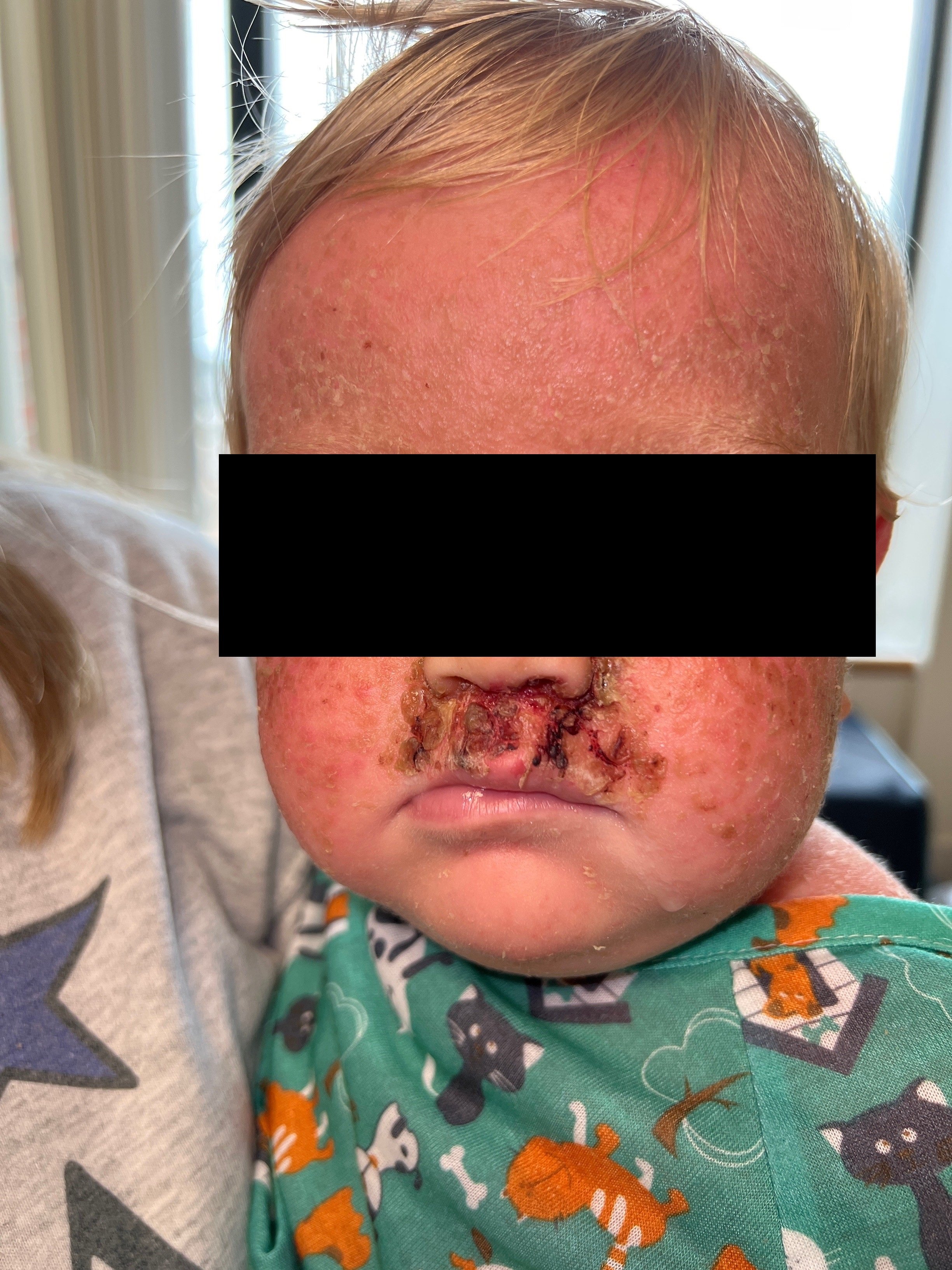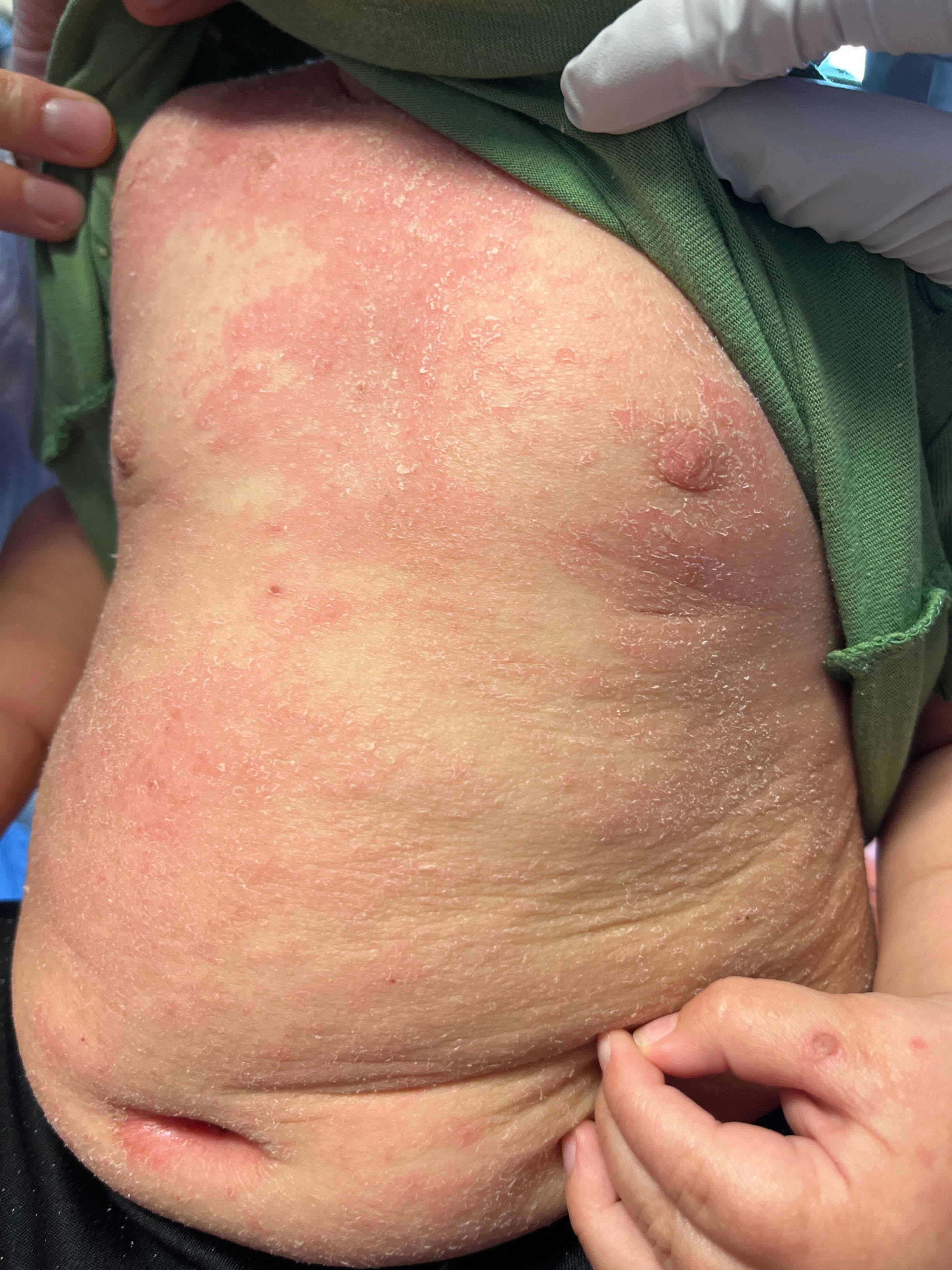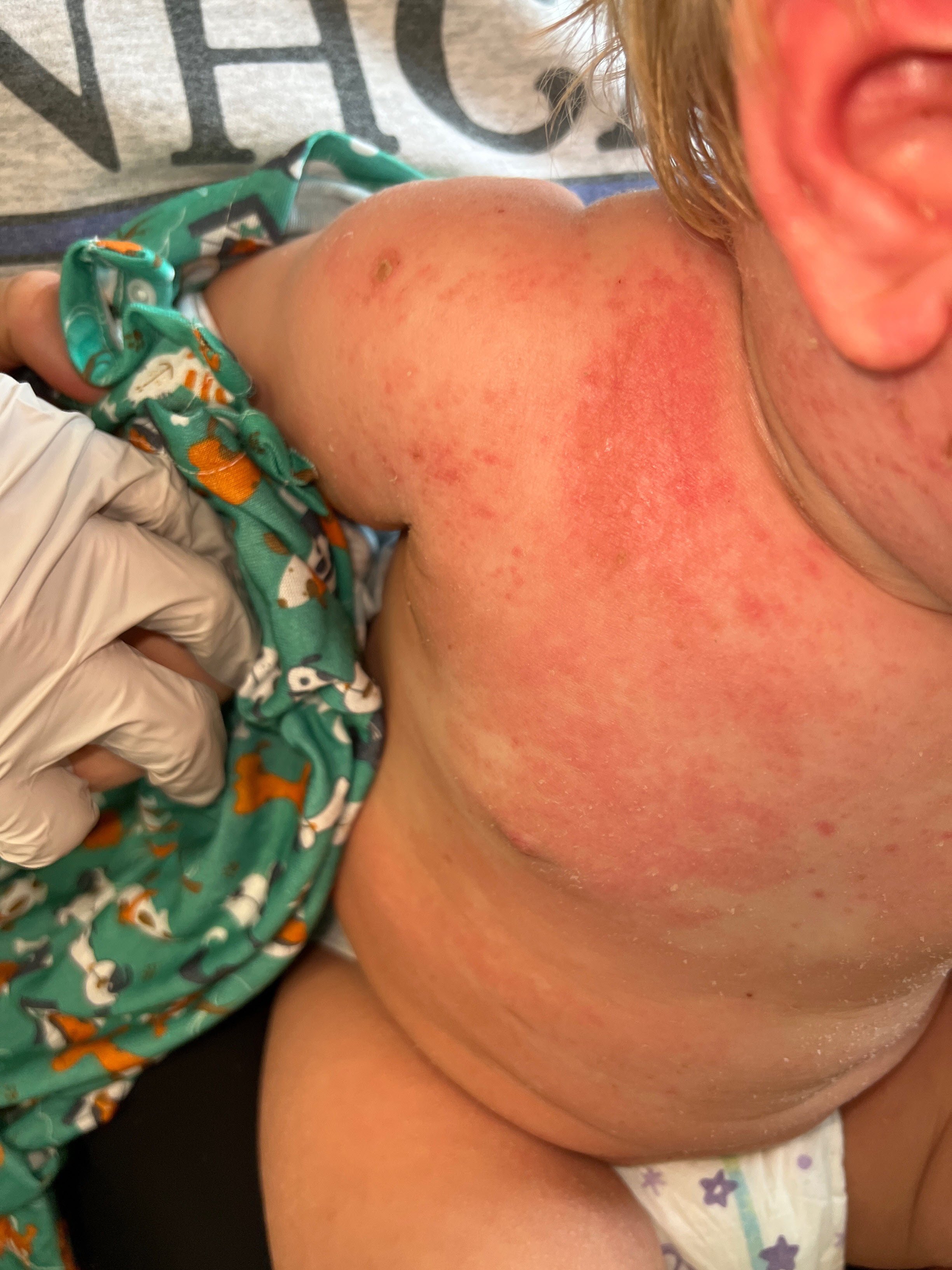What's the Diagnosis?
August 2022
Visual Diagnosis
Author: Chia-Chi Angela Fu, MD | Internal Medicine – Pediatrics Resident, PGY-2
Column Editor: Joe Julian, MD, MPHTM, FAAP | Hospitalist, Internal Medicine – Pediatrics | Clinical Associate Professor, Internal Medicine and Pediatrics, UMKC School of Medicine
A 12-month-old unvaccinated boy is admitted to the hospital from a primary care office for concern about diffuse scaling rash on face and trunk. Symptoms initially started the week before with an erythematous rash on his face, most notable on his cheeks. His lips and eyes also appeared swollen. He recently tried wheat for the second time (older brother has severe wheat allergy). Concerned about an allergic reaction, his parents started diphenhydramine twice a day with no improvement. Two days into the illness, a sunburn-like rash appeared from his face to trunk with yellow discharge around his eyes. After visiting another physician, they were recommended to use topical lotion for sensitive skin. When applying lotion, mom noted he would flinch during application. By day 5, the rash began to peel and had progressed to most of his body. The next day, at the pediatrician’s office, it was recommended that he be admitted to the hospital.
During his illness, mom denies any fevers and the patient has had normal appetite, stooling and voiding patterns. The patient has possibly been rubbing his chest from itchiness. No new skin exposures, changes in detergent, body wash, prolonged sun exposure or animals at home.
Vital Signs and Physical Exam
Vital signs in the pediatrician's office are temperature of 38.6 C, heart rate of 144 bpm, respiratory rate of 48 breaths/min. Below are pictures on presentation:



Of note, further desquamation was induced with tangential pressure on exam.
Which of the following is the most likely diagnosis and best treatment?
A. Atopic dermatitis – hydrocortisone and topical emollients
B. Staphylococcal scalded skin syndrome (SSSS) – beta-lactam antibiotic and topical emollients
C. Bullous impetigo – beta-lactam antibiotic
D. Stevens-Johnson syndrome/toxic epidermal necrolysis syndrome (SJS/TENS) – stop suspected medications
E. Eczema herpeticum – acyclovir and topical emollients
Answer: B. Staphylococcal scalded skin syndrome (SSSS) – beta-lactam antibiotic and topical emollients
Although a variety of rashes can occur in children, several that are caused by bacteria are important to keep in mind. The most common pathogens are staphylococcal species and streptococcal species.
Staphylococcal scalded skin syndrome (SSSS) is caused by an exfoliative toxin released by S. aureus, which circulates throughout the body and causes blisters distant to the initial site of infection. SSSS occurs in young children because of decreased renal toxin clearance and lack of toxin-neutralizing antibodies. The clinical presentation is often a prodrome of malaise, fever, irritability and severe tenderness followed by large, fluid-filled bullae that are quick to rupture. Patients with SSSS require hospitalization and IV antibiotics. With improvement of skin findings, patients can be discharged on oral antibiotics for a full course of seven to 10 days of treatment.
Impetigo can be non-bullous and bullous, where non-bullous is caused by direct insult of bacteria and bullous is caused by a toxin like SSSS. However, bullous impetigo is localized. This patient had diffuse rash, and if the exudate beneath crust or fluid from bullae is cultured, it is possible to identify a causative pathogen. However, if distant bullae in SSSS (not from the initial insult of the skin) are cultured, they will not yield any pathogen. Main areas to culture in SSSS are nares, umbilicus and perineum.
SJS/TENS would include mucosal involvement, whereas SSSS usually does not. This patient’s only recent exposure to medication is a first-generation antihistamine, which is not a drug associated with SJS/TENS reaction. Most common culprits of SJS/TENS are anti-epileptics, trimethoprim-sulfamethoxazole and beta-lactams.
Atopic dermatitis is a chronic inflammatory disease of the skin which can be complicated by bacterial or viral infections. It is theorized to be a breakdown of skin barrier and characterized by intense pruritus and eczematous lesions. This patient did not initially present with any pruritus, although mom did report “eczema” in his history. One of these severe complications of atopic dermatitis is eczema herpeticum, an infection caused by herpes simplex virus which involves skin and mucosa. Eczema herpeticum is characterized by disseminated non-grouped vesicles and pustules that can erupt up to a week later.
Clinical Course
This patient improved significantly with cefazolin and topical emollients (good ol’ Vaseline). Swabs of the purulence around his eyes, mouth and umbilicus were cultured and grew methicillin-susceptible Staphylococcus aureus (MSSA). He was discharged on hospital day 3 with cephalexin to complete 10 days of antibiotics.
References:
- Dollani LC, Marathe KS. Impetigo/staphylococcal scalded skin disease. Pediatr Rev. 2020;41(4):210-212. PMID: 32238552. https://doi.org/10.1542/pir.2018-0206
- de Bustros P, Baldea A, Sanford A, Joyce C, Adams W, Bouchard C. Review of culprit drugs associated with patients admitted to the burn unit with the diagnosis of Stevens-Johnson syndrome and toxic epidermal necrolysis syndrome. Burns. 2021;S0305-4179(21)00220-5. Published online August 18, 2021. PMID: 34924230. PMCID: PMC9124451. doi:10.1016/j.burns.2021.08.009
- Traidl S, Roesner L, Zeitvogel J, Werfel T. Eczema herpeticum in atopic dermatitis. Allergy. 2021;76(10):3017-3027. Published online May 3, 2021. PMID: 33844308. doi:10.1111/all.14853


